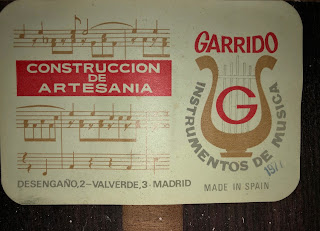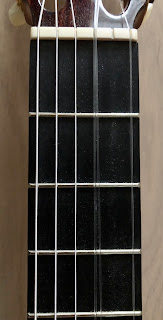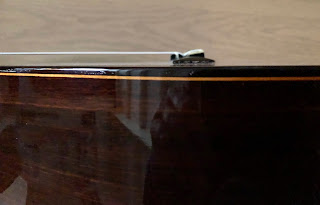Guitar distributed by Casa Garrido in Madrid, Spain,
Garrido worked with several builders from different parts
of Spain, such as Ricardo Sanchís, Juan Estruch, Modesto
Borreguero, Telesforo Julve, among others, it is the history
of Spanish lutherie. It is a solid wood guitar with a good
and authentic Spanish construction. Wood: Solid cedar
soundboard. Sides and back solid rosewood, with long
drying time. The marquetry details are of the time, beautiful.
The sound is vintage, very versatile, you can see the
personality that this builder put in his guitars, very com-
fortable and light to play The condition is good, it shows
hardly signs of use. Scale: 657 mm. Width nut: 53 mm.
It is to be noted that a Vicente Camacho labelled guitar
on the site of Vintage Guitar World has exactly the
same scale: 657 mm. That guitar is also from 1977. Odd
thing is that in both guitars the date has been stamped.
NOT FOR SALE.
A beautiful rosette but difficult to determine wether
if this is the work of Vicente Camacho as he made
a big variety in rosette designs.
Every picture can probably tell us more about this
high quality guitar, but who was the builder? Anyway,
the cross bar, Vicente Camacho used in his guitars is
present in this guitar as well as the long and flat
horizontal brace under the bridge. Inner woodwork
is of a high quality. Furthermore the soundboard
has been provided with a 5 piece fan bracing.
A cedar topped guitar in the Madrid tradition of that
time, initiated by Jose Ramirez III. This soundboard
really resembles the soundboards used on the 1A
model of Jose Ramirez in that it is narrow grained
and shows medullary rays that gives it a kind of
silky pattern. Vicente Camacho didn't use the 665
mm scale that much, popular at that time in Madrid.
The own frequency of the soundbox lies quite low:
on a F# which means around 92,5 Hz.

Garrido appears to be a retail store brand with the store in
Madrid, Spain. Came across this brand on eBay – a purported
1960s classical guitar (Brazilian Rosewood) labelled Garrido with
an association with the luthier Modesto Borreguero. According
to Acoustic Guitar Forum, Modesto Borreguero set up his own
workshop in 1952 and worked exclusively for the dealers Casa
Garrido in Madrid. He also taught the now retired maker
Vicente Perez Camacho (b.1928).
Borreguero (b.ca.1893 in Madrid) retired from guitar
making in 1963 and he died in 1969.
Garrido Classical guitars have a long tradition of construction
in Spain, and the first units in 1955 soon became a quality
standard within its mid-range guitar segment. Nowadays, Garrido
guitars have construction and sound at the best price. See:
This information comes from the Jedistar site. Not
entirely correct as the second label here attests Casa
Garrido being already present in 1953 and possibly
even 1952.
Though Casa Garrido sold guitars in different price
ranges, this guitar can be considered "Concert Quality".
Camacho built even more elaborate models with lots
of ornamentation.
As for the address, Casa Garrido was situated:
Desengano 2 - Valverde 3 are both in a way mentioned
to be the workshop of Modeste Borreguero. Both Vicente
Perez Camacho as Modeste Borreguero sold their guitars
to the Garrido music shop in Madrid.
Nicely shaped head with a topnut that is fine tuned.
The headform definitely points towards Vicente
Camacho as a luthier. Also the rather wide sleeves
can be considered a Camacho trademark as is the
rather flat inner tongue.
No damage on the top of the head which often
occurs when placing a guitar against a wall. The
often used ebony reinforcement strip in the neck
can be studied here as well.
This guitar must have been stored by a collector as
there are hardy any traces of normal use on this guitar.
Therefore the frets are still in a like new condition.
The wood remains a bit questionable to me as it has an
orangy character here and there that reminds me of Brasilian
rosewood. The cedar top anyway can be compared with the
first grade quality Jose Ramirez III uses on his 1A concert
instrument. Very fine grained.
The slanted bridge tie block can be studied here.
General information about Vicente Perez Camacho:
Vicente Perez Camacho was born in Madrid in 1928.
Like so many guitar makers of his epoch he apprenticed
first as a cabinet maker, beginning his working life
when he was eleven. In 1952, he decided to apprentice
with Modest Borreguero (1901-1969, one of the famous
guitar makers to come out of the Manuel Ramirez
workshop, who he had known since 1943. Vicente worked
in Borreguero's small workshop on the Calle Desegano
No 3 until he decided to open his own workshop in 1959
on Amparo No 3. During the 1960s Vicente sold his guitars,
as did Borreguero for some years, through Garrido, one
of the major music stores in Madrid for many years.
Vicente retired in 1992. This could be one of those sold
through Garrido. It bears the stamped Casa Garrido label
A choice of maple is not as unusal for flamenco as it might
appear. Until the 1930s, maple was the top choice for a fine
flamenco guitar, and only fell out of favor because during
the depression, few could afford it and local cypress was
much cheaper. There are not any cracks repairs or issues.
The guitar still has its' original lacquering: the finish is
flawless. Mechanical tuners (probably Fustero's) appear
to be original.
A post by someone who owns a Vicente Camacho guitar.
Actually I do have a V. Camacho made in 1975, cedar top, Indian rosewood
back and sides. A very nice guitar, 66 cm, rather light (much lighter than the
Ramirez 1a of this time, and also less weight than most other guitars that
I know - except for some flamencas). The 5 fan-style braces look quite
usual, with a long and flat horizontal brace under the bridge, but a diagonal
asymmetric harmonic bar (less diagonal than in the Ramirez), starting and
ending at ribs. The head shape is quite special (like Santos but with a
"Ramirez" tip in the middle), and the rosette (individual, never seen another
one exactly like this) has the Madrid colours (red, green and black wood)
and it is repeated on the bridge. The label is dated, signed and stamped,
and the sound board is stamped again on the inside close to the bridge.
Clearly individual work, and the man was proud of his product.
Concerning the sound, it is suprisingly loud, but lighter and clearer trebles
than the Ramirez of this time that I know. Lots of overtones, beautiful
harmonics, well balanced, especially the basses are not too loud, but present.
I cannot compare with any other guitar that I have. Also, it is easy to play,
because of the nice neck (width 52 mm at the nut).
This is indeed one of my favourite instruments.
Vicente Camacho designed a cross-braced system for the guitar top that produces a loud and clear tone even in small body guitar. The tone is well balanced and projects really well. If you have heard El Trio Los Panchos, you will recognize the sound. Camacho’s guitars are also famous because they were one of a kind piece of art. Every single part was made by the luthier, except the machine heads. His rosettes looked similar to each other but were different. The design matches the bridge. None of his guitars is equal to another. He made small scale guitars by demand. He used spruce, cedar, Indian and Brazilian rosewood mainly.
Among his collectors are Angel Romero, Peter Capell, Emma Martinez, Greg Lake, Pepe Vergara and Ramon Villar.
Camacho was very well known in London, where his guitars were sold by the London Guitar Studio. An interview with Vicente Camacho was published by Classical Guitar Magazine in July 1986.
Some of his guitars have Garrido brand on the sound hole label (circa 1960s) as he sold his guitars fro many years through this Madrid store.
From the Zavaletas Site:
In 1952, Borreguero moved his workshop to Desengaño No 4, and began to build exclusively for the music store Casa Garrido. There he also took on the training of Vicente Perez Camacho, who went on to become a noted luthier. He also taught a young Felix Manzanero how to French polish, a skill that allowed Manzanero to enter Jose Ramirez III workshop as an apprentice.
VICENTE CAMACHO
Vicente Pérez Camacho nació en Madrid en 1928. Como tantos guitarreros de
su época, primero aprendió cómo ebanista, comenzando su vida laboral a los
once años. En 1952 comienza como aprendiz de Modesto Borreguero.
Vicente trabajaba en el pequeño taller de Borreguero en la calle Desengaño Nº 3
hasta que decidió abrir su propio taller en 1959 en el Amparo nº 3.
Durante los años 60 Vicente vendió sus guitarras, al igual que Borreguero durante
algunos años, a través de Garrido, una de las tiendas de música más importantes
de Madrid. Vicente se jubila en 1992.
Translation:
VICENTE CAMACHO
Vicente Pérez Camacho was born in Madrid in 1928. Like so many guitar players
of his time, he first learned how to become a cabinet maker, beginning his working
life at the age of eleven. In 1952 he began as an apprentice of Modesto Borreguero.
Vicente worked in the small Borreguero workshop at 3 Desengaño street until he
decided to open his own workshop in 1959 at 3 Amparo. During the 1960s Vicente
sold his guitars, like Borreguero for some years, through Garrido, one of the most
important music stores in Madrid. Vicente retired in 1992.
Manuel Adalid
This luthier sometimes used labels that were mentioning Casa Garrijo - Madrid.
To my opinion it must also point towards the Casa Garrido company described
here above!

A remark around this guitarrero made by Siegfried Hogenmueller:
"Did you know, that in the 60es of the past age he had worked for Hernandez y Aguado
from time to time? And, as he has learned most from Modeste Borreguero, it could be
realistic, that MB advised his later student to collect experiences from HyA." (With
many thanks to Mr. Hogenmueller for this contribution.)
The guitar in France:
They all came with their Spanish guitars and the first Ignacio Fleta guitars
showed up in Paris in 1955 in the hands of Sierra and Cueto. They were im-
mediately greatly admired and gradually caused the guitars of Torres, Manuel
Ramirez, Esteso, Simplicio, Garcia, etc. to be put back in their cases. Other
makers, such as Conde Hermanos, Mateu, Vicente Camacho, Arcangel
Fernandez and De la Chica, found a place on the French market where they
sold hundreds of their instruments.














Geen opmerkingen:
Een reactie posten